The Marquesas:
The Marquesas are a part of French Polynesia. You may be much better informed than we were until we got here, but we had a rather hazy idea of its extent, which is huge. It covers an area of the Pacific about the size of Europe and is made up of a number of groups of islands, of which the Marquesas are one, at the north eastern edge. They have a population of only about 8000, out of 220,000 in the whole of French Polynesia.
Fatu Hiva is the southeastern-most island in the Marquesas, which are all quite young, volcanic, very steep islands, with no reef around them, unlike many other, older Pacific islands. This has one disadvantage from a sailing point of view, or rather an anchoring point of view, in that there is constant swell in most of the anchorages, so the boat is always on the move, sometimes rolling quite badly. However the islands we visited were so charming, it was hard to mind.
Fatu Hiva is far from the administrative centre of the Marquesas, so has to be reasonably self-sufficient. It is described in the Lonely Planet guide as “an island of superlatives: the most remote, the furthest south, the wettest, the lushest and the most authentic”, with a population of just over 600 in two main villages, and we found it delightful.
|
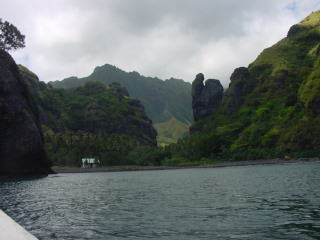
|
Hanavave is hardly a “bay” in the normal sense, but a deep indented V, the end of a valley between very high steep hills, almost all the surfaces totally green, whether from trees, coconut palms or grass. Huge fingers of rock jut upwards from the cliffs on the north side of the anchorage, making it really spectacular but almost impossible, needless to say, to capture on film! One could really only appreciate how tall the cliffs were when looking from a distance at the tiny yachts beneath them.
|
Our first surprise was to notice what at first sight appeared to be an eight, row past in the dusk of our first evening, only to realise that it was actually a cox-less six, being paddled, rather than rowed, and was in any case a proa – a full-sized canoe with a small outrigger hull to one side for stability. But the training was unmistakable, and the effort and concentration much as you might see on the Thames. Ashore, we were even more surprised to see that it was made of fibreglass – a far cry from the hollowed out logs of the San
Blas.
It turns out that these are keenly raced across French Polynesia, with a major regatta in Papeete around the 14th July. No doubt the French equivalent of the Sports Council had something to do with the new fibreglass boats – we noticed that every small village in the Marquesas had at least one!
Every evening at dusk, fishermen would paddle quietly past in their small canoes (always with outriggers) and come back laden with large game fish, much to the amazement of even the most successful fishing yachtsmen.
Going ashore the next morning to explore the village, we were struck by the air of care for the village, and even affluence. The concern for appearance evidenced by flowers in tubs, (some tubs being grain sacks!), gardens, and colourfully painted, often pre-fabricated houses was striking.
There is no bank in the village, and the local currency is the Cour de Franc Pacific, which of course no-one had, so two forms of currency were in use – the dollar in the boulangerie and small shop, as everywhere, it seems, but also barter. Fresh vegetables and fruit were not on sale, but as we walked up the street, a number of people approached us offering fruit “pour echanger”. We asked what would be an acceptable exchange, and were told tins of corned beef, tins of instant coffee, dried egg, perfume, things for children. We had some of the former, but only enough for our needs, and little of the latter, so went back to the boat to see what we could find. In the end we exchanged various tins of food and bottles of nail varnish (bought for the purpose) for bananas, oranges and limes, an outboard motor spark plug for two huge pamplemousse, easily twice the size of a normal grapefruit, and a couple of tins of stewing steak for several pounds of fresh tuna, beautifully prepared. It took some getting used to, and the scale of value was interesting – fruit seemed expensive, but the tuna extraordinarily cheap.
The inhabitants grow the fruit around their houses – and in that climate it seems to grow with ease. However they eat no vegetables, so none were available, and though there were chickens everywhere, there were no eggs available “until the next supply ship”. It seems that the dogs eat the eggs, and no-one has thought to provide the chickens with nesting boxes so that they can collect the eggs before the dogs can. We did notice that every garden had a small pig tied up by the hind leg.
We witnessed the arrival of a supply ship one day – so vital to island life. As we went ashore, we noticed a large number of people waiting by the small quay where we landed our dinghies in the swell. On returning back down the concrete paved village street, we could see the ship arrive and drop anchor well outside all the yachts (to our relief). It lowered a totally square lighter, powered by two outboard engines and onto which it proceeded to unload its cargo – washing machines and drums of diesel and petrol labelled for individual families, new paddles for the canoes, and so on. The washing machines were loaded onto the backs of small trucks, but many of the goods were wheeled home in wheelbarrows. The whole delivery was completed with several trips to and from the ship in about an hour, and the ship went quickly on its way.
In walking round the village, we heard sounds of power tools and near one house saw a man working on a 3 foot high carving of a woman, and went over to have a look. It appeared to be of Mary, with her hands and the folds in her dress most beautifully executed, though a hard-looking face, so we asked if it was for the local church, but it turned out to be for an exhibition and competition in Tahiti, as part of the July 14th festivities. The man offered to show us the rest of his work, also prepared for the exhibition, and we were led into a large room in his house whose floor was completely covered with large carved objects – often lizards or turtles several feet long, most intricately carved, with opening lids in their middles to create a form of dish. They were extraordinary pieces, quite beautifully made, mostly of rosewood, and gave us first hand experience of the highly reputed Marquesan carving tradition.|
|
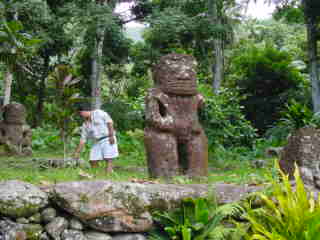
|
Down the road, another man was carving tikis from large, very heavy sections of a long straight branch, using a chainsaw and then a power sander. These were for sale to tourists, and in quite a different class to the work we had seen earlier, though they would have made good doorstops! His wife was engaged in another traditional Polynesian craft, that of “tapa” or bark cloth. Here bark is taken from paper mulberry, breadfruit or banyan trees, soaked, pulverised by beating by hand, and then beaten out also by hand into large sheets of material on which traditional designs are painted. These were rather fun and we used a calculator and a cotton jersey to reduce the drain on our dollars to buy a couple of her designs – a traditional tiki-based design, and a turtle which signifies good luck in Marquesan culture.
|
It was interesting though, that apart from being approached by some of the women to make exchanges for fruit, we were not offered items for sale, and indeed heard about the tapas from another yachtsman. Again very different from the determined selling – and sometimes, frankly, begging – of the Kuna in the San Blas. But the Kuna are not eligible for child allowance and other benefits of French government support, which may explain their attitude.
There was a lovely walk up to a waterfall (huge fall, not a great deal of water!) up through woods, with huge trees and large versions of plants one normally sees in pots at home, past streams rushing down between ferns and boulders (would easily win a prize at Chelsea in the wild water garden category!) and then finally a scramble over boulders, round rocky outcrops and under fallen trees to the bottom of the fall, and a bracing swim in the very cold water. The rainfall is evident in the lush landscape, but it didn’t seem to rain all that much while we were there, though there were always clouds gathered round the tops of the mountains of the island.
After several delightful days in here in Hanavave Bay, we had to move on and decided to go north via another small island, Tahuata, just south of Hiva Oa, the administrative centre of the southern group. We sailed in close enough company with Just Magic to be able to take photos of each other under sail, and arrived later that afternoon off the small village of Vaitahu, escorted into the bay by dolphins including at least one mother and calf. We anchored in what seemed like a sheltered part of the bay, but once we had gone to bed, a swell came rolling in, making for an uncomfortable night. While anchored there, we saw three spotted rays playing in the water nearby.
We went ashore to look around the following morning, finding another well kept village with a small but very well stocked store, which only took Cour de Franc Pacifique, but with no bank, we still couldn’t buy fresh eggs (the ones bought in the Galapagos were universally found to be quite stale even at first purchase, and after 3 weeks at sea and nearly a week ashore, they were no longer usable).
There was also a magnificent new catholic church, faced in small round stones, all beautifully pointed, and with magnificently carved doors and a huge wooden statue of virgin and child which seemed to be quite inaccessible upstairs in a niche looking out to sea, so that one could really only see it through binoculars from the boat.
Polynesian singing is supposed to be unsurpassed in services, and all visitors are recommended to attend at least one service, if only for the singing. We had anyway decided to stay for the service the following morning, but Barry and Annette, with more time to spend in the Pacific than we have, decided they couldn’t take another night of rolling and moved on round the corner to a more sheltered bay.
We weren’t alone in the anchorage though as a number of American boats arrived that afternoon and it transpired that every yachtsman in the bay attended the service the following morning. Despite having a copy of the Catholic mass, we found the service impossible to follow – all of course in Marquesan, but there didn’t seem to be enough words at any point in the service for us to be able to work out, even from the beginning, where we were. However there was plenty of enthusiastic singing, apparently of the same refrain, regularly repeated throughout the service and accompanied by guitars and a large drum, played (very well) by a boy on whom it came chest high. In the absence of comprehension, one could look around, admire the church itself and the sunlit stained glass in the east window, and listen to the music. It was interesting to see many of the women with flowers in their hair, or behind an ear. Although you tend to see such things in tourist photos of scantily clad beauties, it was rather touching to see an elderly lady wearing a flower for church. One woman was wearing a large garland around her neck which during the collection was taken to the altar where the chalice and paten for the communion were placed inside it. Unlike in Martinique, where church was clearly left to the women, here there were men and women and many children, all sitting at the front and remarkably still.
That afternoon, we sailed the short distance round to Just Magic’s nice still bay and the following morning experienced a wet beat (the first for many months as our sailing has all been downwind since the San Blas) across to Atuona, the main town on Hiva Oa, to complete entry formalities, do some shopping, and visit a Marquesan archaeological site. Again we were escorted by dolphin with young – a particularly lovely sight.
In Atuona, we met a number of fellow yachtsmen just back from an excellent trip across the island to the site, so we signed up on the spot for the same tour the following day. This proved very interesting – 6 of us in a jeep with our local guide, who spoke excellent English and was prepared to talk about all aspects of Marquesan life and history. We drove through spectacular scenery – steep hills and valleys clad with wonderful greens of all sorts of native and imported trees – to the other (north) side of the island, where again the coast was dramatic with steep bays and headlands. We heard many local stories, histories and legends, of which several stand out in our memories.
The relationship with the French is interesting – love/hate, as with so many colonists, but the Marquesans (at least as represented by Pepe Rou, our guide) seem to be as clear-eyed and pragmatic as the French themselves and recognise the clear benefits of French investment. French Polynesia was granted a degree of autonomy some years ago, and for the Marquesans that has been less successful than direct rule from France. The population is centred in Tahiti, so of course the locally elected president is Tahitian, and he is seen as much less fair in his distribution of the French purse away from his own back yard than the French were! There has been an independence movement, partly fuelled by the nuclear testing in the Tuamotus, and Pepe Rou was convinced that the Marquesas would vote to stay French rather than for independence. We saw enough evidence of road building and maintenance, electricity supply and so on to be convinced! No island of 1800 people could otherwise have such good infrastructure.
We stopped at one point overlooking the channel up which we had sailed from Tahuata, and Pepe Rou recounted the story of a French battle with the Marquesans which ended in the rape of many young women, including the Chief’s own daughters. He recognised though that against guns, he was relatively powerless, so he persuaded his people to bide their time, and finally the French ship’s company was invited to a great feast. They were seated in their places, each with a Marquesan on each side, and the feast was laid out in front of them all. The French captain was puzzled, though, on looking at the prepared fare and asked the Chief “but where is the meat?” and the answer came (recounted with relish by Pepe Rou) “you are our meat” and at that the Marquesans massacred the French and cooked some of them. Of course these stories of cannibalism abound and create a certain frisson when you realise that it was not much more than 100 years ago that cannibalism ended here.
|
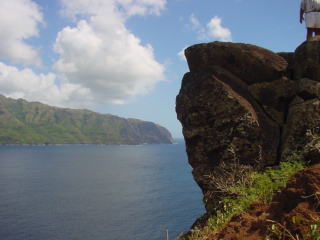
|
Another interesting and horrifying story was told to us at another spectacular viewpoint, on a rock with a sheer drop to the sea, where a sacrifice of a virgin was made to the gods of the sea and wind. The eldest daughter of the Chief of the tribe had the honour of being selected to be sacrificed to the sharks, by being thrown off this rock … alive, and covered with animal blood. Not much incentive to remain a virgin.
|
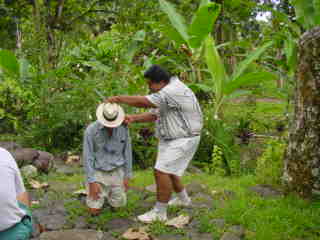
|
When we got to the archaeological site – a scene of religious and tribal rituals – it appeared that the eldest son too had a role in a very much more convoluted sacrifice. The site itself was beautiful, at the base of a high vertical cliff, and, though cared for, has been overtaken by the encroaching vegetation and trees. Large stone tikis still in situ and the dry stone walling of the bases of the ceremonial areas well restored. The tikis were carved to represent dead warriors or chiefs, to give them a form of immortality, though they subsequently also came to be worshipped as well, as far as we could make out. One unusual female tiki shown in the photo section represented the Marquesan “giving birth” posture. There are not many, if any, western accounts of these rituals, as the sites were “tabu” and any foreigners found near them, even when no ritual was underway, would have been killed. So the stories have been handed down by word of mouth since the rituals stopped, again, just over a hundred years ago. Without a close knowledge of the culture, some were hard to follow, but involved the celebration of successfully fought battles, the glorification of the Chief, and religious rituals and ceremonies. We were struck by the atmosphere and beauty of the deserted site, as much as by the accounts of the ceremonies. You will see in one of the photos we took Pepe Rou using John to demonstrate the appropriate level of submission required from a defeated foe just before his head was chopped off! After this, if the enemy was a chief, the eyes, brain and mouth were eaten by the triumphant chief to absorb the understanding and directing skills of the defeated one.
|
The Polynesians have an entertaining version of the creation story in which God decides to create and then bake man. He put three men into his oven, and after a while took one out, but he was white and raw. “That is you, my friends”, said Pepe Rou. Then God took the second man out and he was nicely browned – just perfect – a Polynesian. But he left the last one in, and after a while there was a smell of burning and God took from the oven a Melanesian. Political correctness doesn’t extend out here!
The trip lasted all day and included lunch in a small restaurant in the village near the site. As we arrived an old man accompanied by three younger ones was setting off on horseback for a two or three day hunting trip into the hills. It transpires that hunting is still very active here and Pepe Rou, among many, has his own hunting dogs both for goats and for wild boar, which he kills with a knife when the dogs, under his command, have driven the beast towards him. It is an athletic business, looking at the very steep country, and clearly highly skilled, with no room for error at crunch time.
So it was interesting to see that though they are embracing French-provided modern technology in some respects, the Marquesans are still keen to keep many of their traditional ways alive. Here on Hiva Oa, they are resisting calls to build hotels for more tourism, wanting to limit the numbers of visitors so as not to create too much impact on their lives. And while they can, with French support, afford to do this, one can see why they would want to. It is a long walk from the harbour into the small town, so everyone hitches a lift, and our first day we were picked up by an Alstom truck, on its way home from work - at about 2 pm. The lifestyle is not arduous, allows time for enjoying the traditional ways – the fishing, the hunting, and so on – but combines with a fair degree of modern comfort. Indeed one of the Alstom workers told us that he had left Tahiti to come to the Marquesas, because of the people, the pollution, the overall busy-ness in Tahiti!
We came back down to earth the following day when the loo pump jammed solid, so we spent the morning replacing it with its spare. It’s easy for us to forget that equipment usage on Flame has increased many fold during this trip, so it’s hardly surprising that constant maintenance is required. In this case the warm sea water had completely filled the inside of the pump and its outlet hose with limescale. We did some hand washing at the tap ashore, bought some fresh bread and sailed back to Tahuata for a last supper with Barry and Annette before we set sail the following morning for the Tuamotus.
|
The Tuamotus:
It was a sad occasion for us to have to say goodbye to Barry and Annette of Just Magic who have become such good friends since we first met them in Arrecife in the Canaries, but our short timescale for this whole trip forces us on at a faster speed than almost every other boat we meet.
However, armed with addresses, email addresses and most important, a radio schedule and frequencies for the rest of the year, at least until they get back home, we said our goodbyes and sailed slowly out of the bay, again accompanied by dolphins and their young.
|
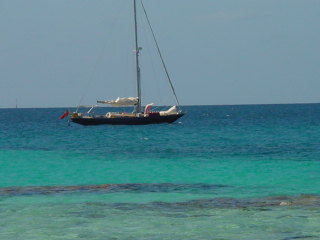
|
We were heading for Raroia atoll in the Tuamotus (widely known because this was where the Kon-Tiki was stranded on a reef at the end of her passage), some 400 miles away - at normal speed a sail of 3 days or so. However, we sailed straight into what we assumed was the wind shadow of the island, and after drifting for a while, decided to motor out a little way to try to pick up the wind. However there was really none to pick up, and, with more than 1000 miles to go till the next possible re-fuelling, and with only 600-odd miles of diesel capacity, we decided we would just have to make the best of what wind we could find. The result was a record slow (we hope an all-time record for us) day of only 40 miles made good, and that included some current with us too! It was not unpleasant drifting along, but rather frustrating, as we had only a very few days available to spend in the Tuamotus and were using up some of them just getting there.
|
We saw a interesting sight one day – a multi-layered chase: a flock of boobies flying over a large shoal of fish, diving constantly; in the water, also presumably after the same shoal, large fish jumping out of the water; and then above the boobies, frigate birds soaring and watching their chance to steal a catch from the boobies. We are constantly amazed by how far from land we see birds flying, but there are generally just one or two at a time, and we could not work out where this large flock had appeared from, but it was a fascinating sight, for quite some minutes as the chase moved across our bows with the shoal.
We were in the path of a front moving up from New Zealand which turned the wind from the usual easterly, through north east, then north west, then south west and then finally as it crossed us, on our fifth day at sea, we had a constant afternoon and evening of heavy rainsqualls, before the wind moved strongly into the south, forcing us to tack towards Raroia into a short steep sea. We were in danger of arriving too early, still in the dark, off the pass into the atoll.
The Tuamotus are also known as the Dangerous Archipelago. They are very low lying, with the tallest object being the taller palm trees, they are known for their strong currents, and before the days of GPS, navigation must have been very difficult. Now, even with GPS, the charts are still based on the original surveys going back into the last century, so although the GPS may know exactly where it is, you have no way of knowing how well it ties up with the charts. All the pilot books of this area emphasise the difficulty and the care required, so we were approaching with considerable caution.
These atolls are interesting – they are at the opposite end of the spectrum from the Marquesas which rise sheer and steep straight out of the sea and have no protective reefs around them. The Tuamotus really consist only of reefs surrounding huge lagoons. Some parts of the reef are substantial enough to form islands, known here as motus, which are often just a few hundred yards across and maybe a mile or so long, on which villages have been built, and on some of the larger atolls, even airstrips. At a much earlier geological stage there will have been volcanic islands where the lagoons now are. They were gradually surrounded by coral reefs, before the islands in the middle subsided, leaving just the lagoon and the reefs surrounding it. The lagoons are often huge – up to 30 miles long and 10 or more miles wide – with just very narrow strips of reef, sometimes but not always covered with palm trees and other vegetation, surrounding them. Quite a few are inhabited, with copra and pearl production the two main industries.
Again, the sheer expanse of the Pacific covered by the Tuamotus is huge – nearly 1000 miles from north west to south east and over 300 east to west, with more than 70 individual atolls. One of these is Muraroa.
The lagoons often only have a single deep water pass open to shipping and yachts, but the sea crosses the reefs on the up-wind side, so that there is always plenty of water trying to escape through the pass. In Raroia’s case the ebb flow is said to attain 8 knots, which is faster than we can motor, and slack water, and even the flood, only lasts for a very short while. One is also supposed to have good strong sunlight behind you as you navigate through coral, so that you can see the dangers ahead, which again, though often charted are not necessarily accurately so.
We spent a fairly miserable night, tacking into the suddenly lumpy sea, while the rainsqualls died away and we tried to ensure that we were close enough for an early entry the following morning, but not too close in case of chart error.
In the event we spotted the first set of palm trees at 0745, about 6 miles from our waypoint off the entrance. We motored towards the pass, trying to see if the beacons shown on the chart were in place (they aren’t always) and arrived off it at what must have been soon after the height of the ebb, with a small area (in the deep water, of course!) of small but standing waves and overfalls caused by the turbulence of the current rushing out. Having had enough of the previous night, we decided we had nothing to lose by trying to make headway – if we failed, we would have to stooge around outside and wait for it to subside.
In the event we were successful and made it straight through the pass, though we found it difficult to read the water depths through that turbulence, so we were relieved that the beacons were all in place. We then followed a well beaconed channel along to the small and only village in Raroia, where we dropped anchor near the only other yacht.
On going ashore, a man came out of his house to welcome us, and told us that there are about 50 adults living on the island, plus their children, and that most people are engaged in pearl fishing. It was immediately clear therefore that there would be no shop (we always hope for bread!), and we noticed that there was no mains electricity. Every house had a bank of solar panels and the streetlights lighting the sandy the through the village each had its own solar panel, mounted on its pole beneath the light. There did seem to be a sort of town hall, and a lovely small church, decorated with shells, but no other “facilities”. We walked under the coconuts following the track between the houses and were enthusiastically waved in to one by Gaston, the only private pearl farmer in the atoll, who wanted to show us his wares. The Tuamotus are famous for their black pearls, which are actually many shades of grey with pink, purple, blue, green, and are rather beautiful. Gaston showed us various different grades and types of pearls, rolling them out of twists of paper – the perfect round ones, in a number of sizes; pear-shaped ones; irregularly rounded ones with very marked lines round them; and totally irregular knobbly ones. All in the variety of shades of dark grey. It was interesting to see them, but they didn’t appeal as a purchase, so we thanked him for showing us. Some of the crew of the American yacht were there too, eating with the family, and we later discovered that they had bought!
The lagoon had a number of sheds or houses on stilts, which were clearly part of the pearl-farming, though we never did discover exactly what they were for.
|
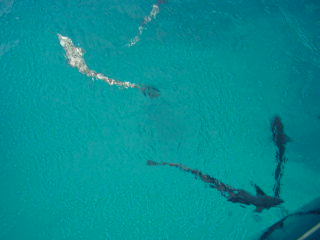
|
Back on the boat, we noticed that there were round the boat some very inquisitive and hungry small grey shark-like fish, which may have been sharksuckers, which apparently use the clearly visible, ridged suction pad on the top of their heads (it looked a bit like a knee pad) to attach themselves to large sharks to enable them to pick up the remains of food the sharks leave behind. The fish rose to the surface for a single breadcrumb over the side and were quite aggressively fighting each other off for crumbs and such like. We didn’t see any sharks, though the lagoon is reputed to have many.
|
Later that afternoon we were approached on the boat by a young man, this time with a matchbox of the knobbly pearls, which he wanted to exchange … for tinned fruit cocktail, nutella or flipflops! We had none and still didn’t want any pearls, so chatted to him for a while before he left. It must be said that the knobbly ones were the most interesting of the lot, but it was hard to know how to, and if one could, have them usefully set.
Given the size of the population, you may imagine our surprise when it got dark, to discover that each beacon we had passed was lit, so that one could, at a pinch, enter the anchorage at night. No doubt to avoid accusations of encouraging wrecks, not one single publication that we have on board mentioned this! We came to the conclusion that the various pilots and guides written for yachtsmen tend to over-emphasise the dangers, but some of our friends have told us that there are many yachtsmen around for whom dangers cannot be over-emphasised! However, everyone we have met seems to be extremely seamanlike and cautious.
The following day we went to explore the reef behind the village, which is on the leeward side of the island. This was our first coral reef and was not at all what we had expected. We had gone to the next door motu, and were first amazed at the dense vegetation which was growing out of dead coral rubble. Not just palm trees, but two kinds of fleshy leaved flowering shrub, an masse, with hundreds of seedlings springing up in the most unpromising looking growing conditions.
Walking beyond the vegetation, we came to a swathe of really rough apparently volcanic rock, which was totally barren, and across that to a wide, flat, pavement-like, pinky-orange expanse of reef. This was partly awash, and the first part we walked across was still fairly barren, though with many tiny stones, covered in different colours of what appeared to be lichen, which moved as you looked at them and turned out to be tiny hermit crabs in tiny shells. Nearer the sea, we started to find small tufts of coral growing out of the pavement, together with more lichen-like growths which almost looked as if they had been poured around the had corals and over the pavement. These latter were in unnaturally vivid purples, greens and yellowy-greens, which made one wonder about the after effects of the nuclear testing, not so far away, though we have since seen them elsewhere! The next stage of the pavement, close to the sea, contained wonderful clam-type creatures, almost totally submerged by and enclosed in the surrounding pavement, and unable to move anything except their brightly coloured, sinister mouths! Finally at the edge of the reef, even on the downwind tide, a tremendous swell surged over the edge above a very sudden, steep drop-off into deep water and there were many brightly coloured large fish swimming around in the clear, clear water.
Walking back again, we decided to walk through the shrubs and trees on the motu to get back to the dinghy and found ourselves walking through dappled sunlight with dead leaves under foot, for all the world like an English wood, except that the leaves were enormous, the ground underneath was still coral rubble, and the rustlings in the leaves turned out to be large hermit crabs in shells the size of a small orange!
It was all very interesting and raised hundreds of questions in out minds, none of which we are able to answer at present. We will be looking out for books on coral reefs once we reach a good bookshop – in Australia, or maybe sooner.
After relaxing here for a couple of days, and completing a few bits of boat maintenance, we hauled up the anchor to set sail for our next atoll. The only thing was that the anchor chain was caught round a coral head on the bottom and held fast, actually pulling chain back off the windlass into the water, the pressure was so great. We had been warned of this possibility – despite the clear water, we had to anchor in about 7 fathoms, and could not properly see the bottom, even if there had been a clear patch to choose. Helen was despatched into the water with goggles to identify which way to move the boat to clear the chain and swam around giving directions to John, who had to shuttle back and forth between the engine controls and the wheel at the stern of the boat, and the windlass control on the bow. After untangling the chain by motoring Flame around the coral heads one at a time and then pulling up the chain, we finally came clear and motored back out through the pass.
This time we managed to time slack water right, though on asking in the village, we had been told to go out to the pass and have a look! This isn’t quite as strange as it seems to us who are used to precise English south coast tide tables, as the flows are very affected by the wind and the swell directions, both potentially pouring water over the reef into the atoll with only the pass as escape route. Weeks later, Just Magic anchored in a pass on another atoll and told us that the current had flowed out for 48 hours without slackening!
We set sail to thread our way past several other atolls to head for Tahanea, an uninhabited atoll, said to have good snorkelling, on the southern side of the archipelago. We were interested to see just how difficult it was to navigate between the atolls, so set very careful waypoints and then used radar to check our distance off – palm trees seem to show up on radar about 7 miles away! But of course you can’t be sure, from the charts, that there are palm trees on the bit nearest to you, and submerged reef won’t necessarily show on radar, so there could always be reef closer than you think. The thought keeps you on your toes, but in fact it all seemed remarkably straightforward, and the largest atoll we had to round had a village with enough lights that we could see its loom in the dark sky (no moon) for most of the night, which was a useful reference point.
We arrived off the pass at Tahanea in a brisk SE wind, motored in with little current against us and down to one of the recommended anchorages. It is on the leeward side of the island again, but this time with very little reef in the atoll to protect us from the fetch (for non-sailors, this means the effect of the wind whipping up waves as it crosses an unsheltered piece of water) across the lagoon – a good 10 miles, so we realised it would be a rather bouncy anchorage. We tried in vain to find a spot clear of coral in which to anchor – despite the “waves” the water was very clear again – and had a choice between apparently slightly less coral-y but deeper, and slightly more coral-y but shallower. We plumped for the latter, partly because it offered the possibility of some shelter behind a small reef from the ESE, should the wind back, as forecast.
However, once settled, with bearings taken on conspicuous palm trees to check that we were not dragging, the wind waited till it was too dark to contemplate moving ( no lights here) and then got up and really made us bounce and snatch at the anchor chain. The first two thirds of the night were anxious and uncomfortable as we took it in turns to check our position, as we were anchored not far from the shore, onto which we would be quickly blown if the anchor didn’t hold, or if the chain wrapped itself round a coral head and, with the reduced scope, break under the increased pressure. We were the only yacht to be seen, and when we talked to Just Magic on the radio the following morning, though by then the wind had dropped and the anchorage was calm, we told them we could see why we were on our own.
|
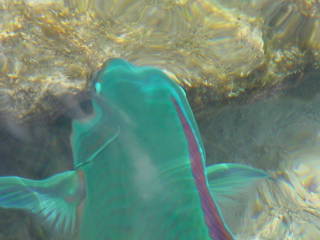
|
However, with the calm, the anchorage became very pleasant, and we went ashore for a walk along the inside side of the reef, which again proved fascinating. Here we were walking along a ledge mostly of volcanic rock like we had walked over at Raroia, and the “pavement” was similar too, but 18 inches beneath the water. This gave us a wonderful view of all the fish swimming among similar small tufts of coral to those at Raroia, as we had the advantage of the height of the ledge, and the smoothness of the pavement as a background for the fish. So without even having to get wet, we saw many of the brightly coloured coral fish, including some large turquiose and pink parrot fish, that one would see snorkelling, and more. Walking along the ledge, we noticed a small turquoise and pink chequered fish, no more than 6 inches long, that seemed to be following us as we walked. There were many small pink crabs at the edge of the ledge which scampered out of our way and into the water as we passed, and first we noticed a lot of splashing from the fish and movement from the crabs nearby, and then gradually we overcame our incredulity to realise that this fish was attacking the crabs as they entered the water. We actually saw it swim off with an unmistakable piece of crab leg sticking out of its mouth! It was hard to avoid the suspicion that it recognised in us a useful if unwitting hunting partner in driving the crabs into the water! W also saw a small moray eel lurking in the shallows, looking very sinister; small coral-coloured reef sharks, very well-camouflaged except for the black and white tips to their dorsal fins; a sea snake wriggling its way away from us at high speed through some rock pools; a huge trumpet fish, 3 foot long, loitering with obvious hungry intent among the smaller fish; and many other multi- coloured fish, in such improbable colours that if you painted them you would be accused of exaggeration.
|
That afternoon we snorkelled from the boat as well, and saw many more fish, busy round the coral heads under the boat, though it was interesting to see that these were mainly small brightly coloured fish, with few of the larger parrot fish and other large fish we had seen in the morning. We also inspected the anchor chain to see how we would free ourselves when we left the following day.
However, we moved again in the night, and again it proved impossible to see from the boat how the chain lay round the coral, so this time John went swimming, while Helen rushed back and forth between wheel and anchor, and finally we were free again, and on our way to Tahiti.
|
|
John & Helen
Fleming
Flame of Gosport
14 July 2001
|
 |
Return to Home Page |
 |
Next bulletin -
30th August 2001 |
 |
Previous bulletin -
7th June 2001 |
 |
Ship's Log
Index |
|
|

